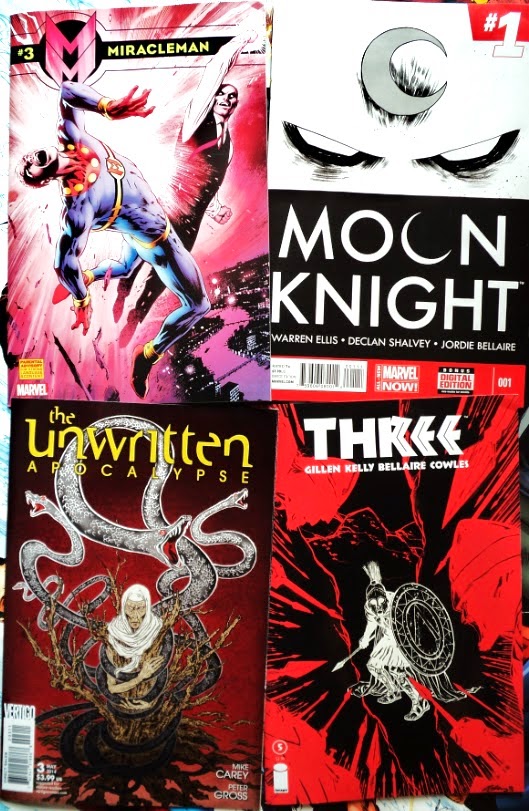JUPITERS LEGACY #4 CVR A QUIETLY (MR)
(W) Mark Millar (A/CA) Frank Quitely. Brandon and his Uncle Walter have instigated the superhero revolution, but there are those who would still stand against them. On the other side of the world, Chloe and Hutch are hiding with their enormous secret and hoping to evade the man charged with hunting renegade superhumans.
MIRACLEMAN #3
(W) TBD (A) Garry Leach, Alan Davis (CA) Alan Davis • Face-to-face with a shocking enemy - can Miracleman survive, or will London burn? • A mysterious man with a sapphire grin stalks Michael Moran. Meet the sinister Mr. Cream. Try not to scream. • A glimpse into the future introduced the Warpsmiths. Now, see these strange warriors battle on their world in 'Cold War, Cold Warrior.' • Including the Miracleman stories from WARRIOR #6-8 and the Warpsmith stories from WARRIOR #9-10, plus bonus content.
(W) Warren Ellis (A/CA) Declan Shalvey. Marc Spector is Moon Knight!...Or is he? It's hard to tell these days, especially when New York's wildest vigilante protects the street with two-fisted justice and three-that's right, count 'em-different personalities! But even with the mystical force of Khonshu fueling his crusade, how does the night's greatest detective save a city that's as twisted as he is? The road to victory is going to hurt. A lot. Marvel's most mind-bending adventure begins NOW as Moon Knight sleuths his way to the rotten core of New York's most bizarre mysteries!
STARLIGHT #1 CVR A CASSADAY (MR)
(W) Mark Millar (A) Goran Parlov (CA) John Cassaday. Forty years ago, Duke McQueen was the space hero who saved the universe. But then he came back home, got married, had kids and grew old. Now his children have left and his wife has passed away, leaving him alone with nothing except his memories... until a call comes from a distant world asking him back for his final and greatest adventure. This issue launches the much-anticipated Millarworld Universe. Get in on the start of something MASSIVE!
THREE #5
(W) Kieron Gillen (A) Ryan Kelly, Jordie Bellaire (CA) Jordie Bellaire, Ryan Kelly. It comes down to this: three versus three hundred at the border of Sparta. The men who'd keep them slaves versus the three who would be free. The historical epic reaches its bloody denouement. The end of a story, the start of a legend.
UNWRITTEN VOL 2 APOCALYPSE #3 (MR)
(W) Mike Carey (A) Peter Gross (CA) Yuko Shimizu. Tom discovers just how quickly the world is dissolving into chaos - and why. But where in all this fractured, insane landscape will he find an ally, and what price will he have to pay? The answer lies in the Divadlo Trinka puppet theatre of Prague, and in the old cliché: 'My enemy's enemy is my friend'.
________________________________________________________________________________________________
________________________________________________________________________________________________
¡He aquí que declaro a marzo como el mes de los mejores y más brillantes autores británicos! De hecho, mi lista de cómics este mes puede ser descrita como una auténtica invasión inglesa: Alan Moore (o El Escritor Original, como aparece en la página de créditos de “Miracleman”, colección que estoy disfrutando más que ninguna otra), Warren Ellis (quien escribe un magnífico primer número de “Moon Knight”, el mejor título de All-New Marvel Now que he leído hasta ahora), Kieron Gillen (“Three” llega a su lógica conclusión), Mike Carey (con una nueva y grandiosa saga de “Unwritten”), y una doble dosis de Mark Millar (“Jupiter’s Legacy” estuvo muy bien, y merece su propia reseña; el primer número de “Starlight” también fue una muy grata sorpresa, posiblemente el mejor cómic del mes). Y ahora, sin mayores preámbulos, aquí están los cómics de marzo:
 |
| my sketch / mi boceto |
JUPITERS LEGACY #4 CVR A QUIETLY (MR)
Brandon y su tío Walter han instigado la revolución de los superhéroes, pero hay algunos que todavía se les oponen. Al otro lado del mundo, un enorme secreto es ocultado.
MIRACLEMAN #3
Cara a cara con un impactante enemigo.
MOON KNIGHT #1
Marc es MOON KNIGHT. ¿O no lo es? Es difícil decirlo, especialmente cuando el más salvaje vigilante de New York protege las calles a puños y con tres, sí tres personalidades diferentes.
STARLIGHT #1 CVR A CASSADAY (MR)
Hace 40 años, McQueen era el héroe espacial que salvó al universo. Pero luego regresó a casa, se casó, tuvo hijos y envejeció. Ahora sus hijos se han ido y su esposa ha fallecido, y lo único que le queda son sus recuerdos… Hasta que una llamada que proviene de un mundo distante le pide que regrese, que emprenda una última y gran aventura.
 |
| my drawing (still in process) / mi dibujo (todavía en proceso) |
THREE #5
3 contra 300 en la frontera de Esparta. Los esclavistas versus los tres esclavos que ansían ser libres. El fin de la historia, el inicio de la leyenda.
UNWRITTEN VOL 2 APOCALYPSE #3 (MR)
Tom descubre qué tan rápidamente el mundo se disuelve en el caos. Y por qué. Pero ¿dónde encontrará aliados en este escenario demencial y fracturado? ¿Y a qué precio? La respuesta está en el teatro de marionetas de Praga y en un viejo cliché: “El enemigo de mi enemigo es mi amigo”.
























